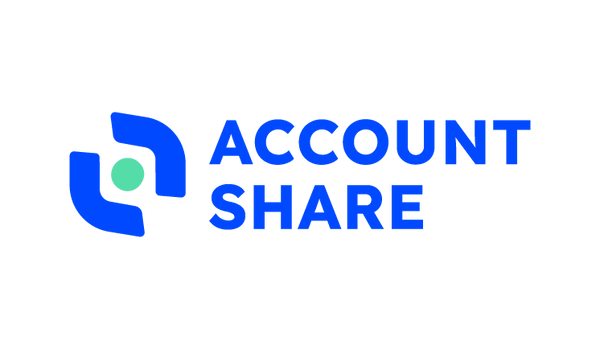
Top Subscription Management Software Picks 2025
Share
Level Up Your Subscription Game
Tired of juggling multiple subscriptions and struggling to keep track of costs? This listicle showcases the top 10 subscription management software solutions to simplify your life. Whether you're a tech enthusiast, a family sharing accounts, a small business owner, a student, or a digital nomad, you'll discover tools to streamline billing, optimize spending, and regain control over your subscriptions. Explore the best options for 2025, including AccountShare, Chargebee, Recurly, Stripe Billing, Zuora, Chargify, FastSpring, Paddle, Recharge, and 2Checkout (now Verifone).
1. AccountShare
AccountShare presents a novel approach to subscription management, leveraging the power of group buying to provide cost-effective access to premium digital services. This platform caters to a diverse range of users, from tech-savvy individuals and families to small businesses and digital nomads, all seeking affordable and efficient subscription solutions. Imagine accessing high-quality subscriptions like ChatGPT Plus, leading AI tools, and your favorite streaming services, all for as low as $10.00 USD per plan. This is the promise of AccountShare, making it a compelling option in the realm of subscription management software.
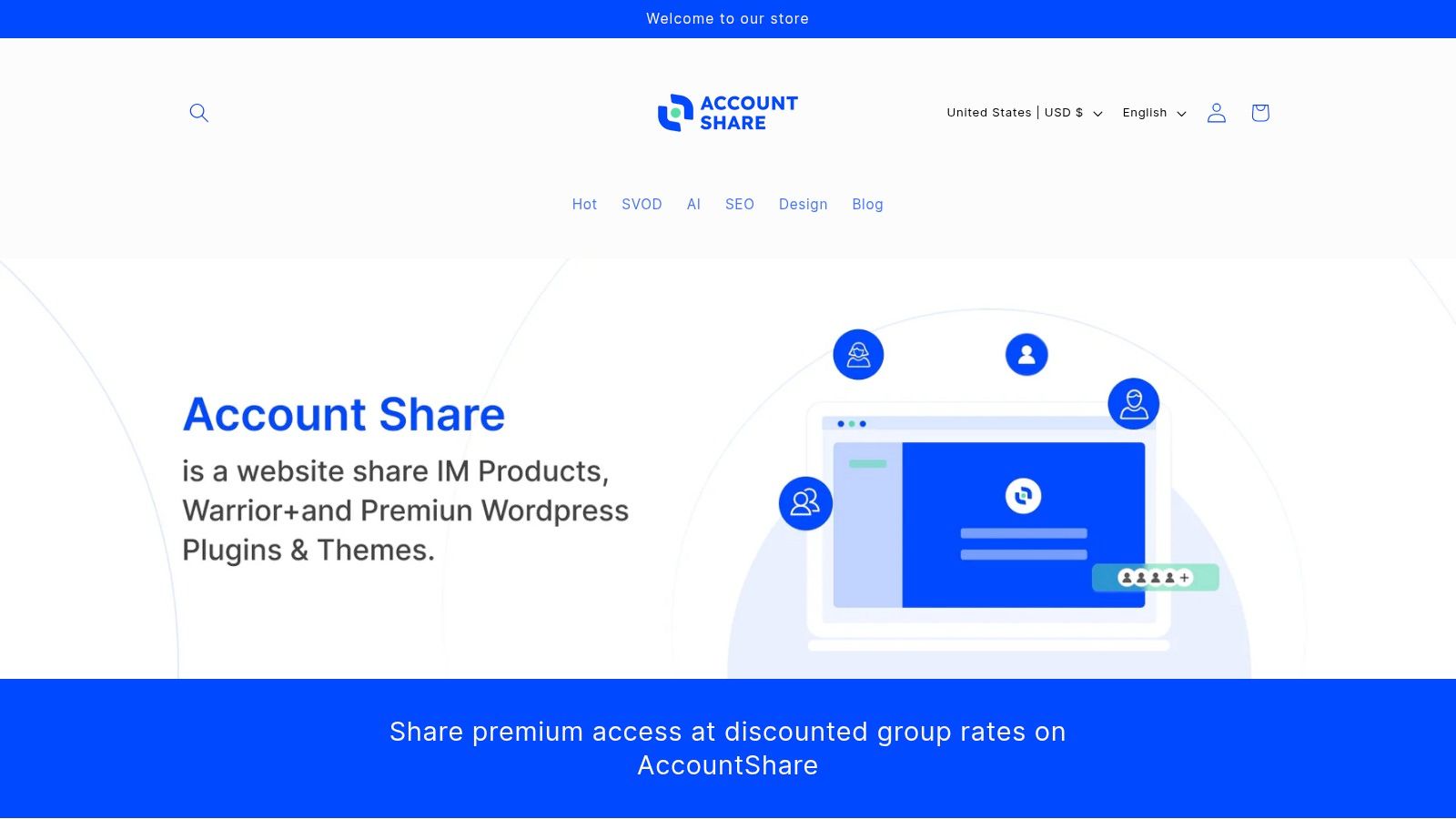
AccountShare distinguishes itself by offering high availability even during peak usage times, ensuring uninterrupted service and faster response times. Furthermore, subscribers often enjoy priority access to new features. The platform prioritizes security with robust measures and customizable permissions, allowing for intuitive shared account management. This makes it an ideal solution for families looking to share streaming and gaming accounts securely, or small businesses needing collaborative access to software tools. For students looking for affordable options and digital nomads requiring efficient account management while on the go, AccountShare provides a practical and cost-effective solution. Learn more about AccountShare to understand the full breadth of their offerings.
Specific use cases include families sharing streaming services like Netflix or Spotify, small businesses collaborating on project management software, or groups of friends splitting the cost of a VPN service. While pricing details beyond the "$10 per plan" mention aren't explicitly available, the cost-effectiveness relative to individual subscriptions is a key selling point. Technical requirements are minimal, requiring only a standard internet connection and compatible devices for the desired services.
Compared to traditional individual subscriptions or even family plans offered by some services, AccountShare offers significant potential cost savings. However, it's important to acknowledge the inherent reliance on trust and coordination among group members. Clear communication and agreed-upon usage guidelines are crucial for a smooth experience. Furthermore, potential legal considerations regarding the terms of service of the shared subscriptions should be taken into account.
Pros:
- Cost-effective access to premium digital services through group buying.
- High availability during peak times with faster response and priority access to new features.
- Enhanced security and customizable account management for reliable usage.
- Diverse service offerings catering to various user groups.
- Strong customer testimonials reinforcing satisfaction and service stability.
Cons:
- Requires mutual trust and coordination among group members.
- Potential legal considerations regarding shared subscription use.
Website: https://accountshare.ai
2. Chargebee
Chargebee is a powerful subscription management software solution designed for businesses of all sizes, from startups to enterprises. Its comprehensive features cover the entire subscription lifecycle, automating tasks like recurring billing, invoicing, and payment collection. This robust platform empowers businesses to efficiently manage trials, upgrades, downgrades, cancellations, and reactivations, streamlining operations and maximizing revenue. If you're looking for a robust, scalable solution for managing your subscriptions, Chargebee is definitely worth considering. Its strength lies in its comprehensive approach to subscription management, offering a wide array of features and integrations to support complex billing scenarios.

Chargebee's integration with over 30 payment gateways, including popular options like Stripe and PayPal, makes it incredibly versatile for businesses operating globally. Furthermore, integrations with accounting software like QuickBooks and Xero, and CRM systems like Salesforce, provide a seamless flow of data across different departments. This centralized approach allows for efficient reporting and analysis, providing valuable insights into subscription metrics and overall business performance. For example, businesses can track churn rate, monthly recurring revenue (MRR), and customer lifetime value (CLTV) to optimize their subscription strategies. Chargebee also supports multiple currencies and tax compliance, making it a suitable choice for international businesses. Its revenue recovery tools, including smart dunning management, help minimize involuntary churn and maximize revenue collection. You can learn more about Chargebee and their features.
While Chargebee offers a powerful suite of features, it's important to consider the potential drawbacks. The platform's pricing can be higher compared to some competitors, especially for growing businesses with limited budgets. The interface, while feature-rich, can be complex and present a steep learning curve for new users. Additionally, some advanced features, such as advanced analytics and reporting, are only available on higher-tier plans. Therefore, businesses need to carefully evaluate their needs and budget to determine if Chargebee is the right fit.
Key Features and Benefits:
- Revenue Recovery: Smart dunning management helps recover failed payments and reduce churn.
- Customization: Customizable checkout pages and customer portals enhance the customer experience.
- Automation: Automated proration and invoicing simplify subscription changes and billing.
- Analytics: Advanced analytics and reporting provide insights into key subscription metrics.
- Global Reach: Multi-currency and tax compliance support facilitate international business.
Pros:
- Extensive integration ecosystem.
- Highly flexible subscription models and pricing structures.
- Excellent customer support with dedicated account managers.
- Comprehensive documentation and API capabilities.
Cons:
- Higher pricing compared to some competitors.
- Complex interface with a steep learning curve.
- Some advanced features require higher-tier plans.
Website: https://www.chargebee.com/
Chargebee deserves its place on this list because of its comprehensive features, robust integrations, and scalability. While it may not be the cheapest option, its powerful capabilities make it a strong contender for businesses seeking a sophisticated subscription management solution. Its flexibility makes it suitable for a wide range of use cases, from simple subscription models to complex recurring billing scenarios. This makes it ideal for tech-savvy individuals, families sharing accounts, small businesses, students, and digital nomads who need advanced and reliable subscription management.
3. Recurly
Recurly is a robust subscription management platform specifically designed to help businesses reduce churn and maximize recurring revenue. It achieves this through sophisticated billing automation, revenue optimization tools, and in-depth analytics. Unlike more basic subscription management tools, Recurly goes beyond simple subscription creation and management. It delves into the complexities of revenue recovery and dunning management, making it a powerful choice for subscription businesses aiming for significant growth. This platform is particularly well-suited for digital media, SaaS, and e-commerce businesses with complex subscription models and a need for granular control over their revenue streams. For those seeking cost-effective solutions, especially small businesses and students, Recurly might be a larger investment compared to entry-level options, but the focus on revenue recovery can make it a worthwhile consideration for long-term growth.

Recurly stands out with its advanced features like automated account updater services that proactively minimize failed payments—a crucial element for businesses relying on recurring revenue. Its flexible billing models allow for diverse subscription plans and pricing structures, catering to various customer segments and product offerings. The built-in analytics and reporting dashboard provides valuable insights into subscription performance, churn rates, and revenue trends, enabling data-driven decision-making. Moreover, Recurly simplifies global payment processing and includes robust fraud management tools, minimizing financial risk and ensuring secure transactions. This can be particularly helpful for digital nomads managing international transactions. Learn more about Recurly to explore how these features might align with your specific needs.
Features:
- Advanced revenue recovery and dunning management
- Flexible subscription billing models with plan management
- Built-in analytics and reporting dashboard
- Global payment processing with fraud management
- Account updater service to reduce failed payments
Pros:
- Strong focus on reducing churn and recovering revenue
- Handles complex tax situations and international compliance effectively, which is beneficial for globally operating businesses.
- Robust API for custom integrations, offering flexibility for tech-savvy individuals and growing businesses.
- Excellent payment gateway reliability, ensuring consistent revenue streams.
Cons:
- More expensive than entry-level alternatives, which might be a concern for budget-conscious users like students or small businesses.
- Limited customization options for customer-facing elements, potentially requiring workarounds for specific branding needs.
- Some users report occasional reporting limitations, although this feedback varies.
While Recurly doesn't publish pricing publicly, it operates on a tiered structure based on transaction volume and required features. Contact their sales team for a customized quote. Technical requirements are minimal, as Recurly is a cloud-based platform accessible through a web browser.
Compared to tools like Chargebee and Zuora, Recurly shares a similar focus on enterprise-level subscription management, although Chargebee offers a wider range of integrations and Zuora is known for its complex billing capabilities. Recurly’s strength lies in its dedication to revenue optimization and churn reduction.
For implementation, Recurly provides comprehensive documentation and support. Integrating with existing systems is typically straightforward through their API. It’s recommended to thoroughly map out your subscription model and billing processes before implementation to ensure a smooth transition.
4. Stripe Billing
Stripe Billing is a powerful subscription management software that extends the capabilities of Stripe's renowned payment processing platform. Designed specifically for businesses with subscription models, it offers a comprehensive suite of tools to manage recurring billing, automate invoicing, and handle complex pricing structures. This makes it a particularly good fit for businesses already invested in the Stripe ecosystem, providing a seamless transition for managing subscriptions. Whether you're a tech startup offering SaaS, a subscription box service, or a membership-based platform, Stripe Billing offers the flexibility and scalability to handle your evolving needs. It earns its spot on this list due to its robust features, developer-friendly approach, and tight integration with the broader Stripe platform.
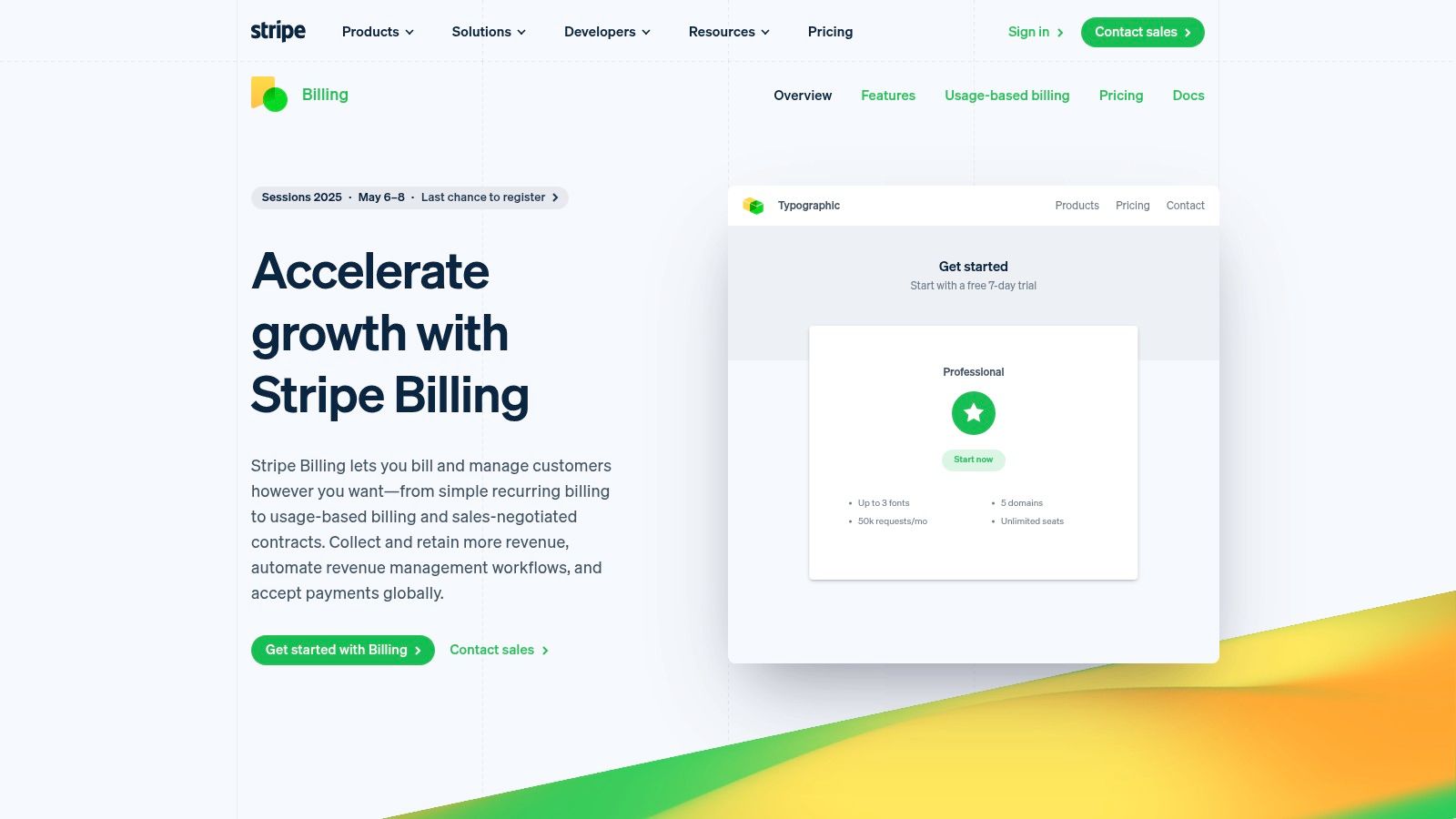
Stripe Billing shines in its support for various billing models, including usage-based, tiered, and flat-rate subscriptions. This flexibility makes it adaptable to diverse business needs. For instance, a SaaS company could leverage metered billing to charge customers based on their usage of specific features, while a subscription box service can easily implement recurring monthly billing. This versatility is invaluable for businesses looking for granular control over their revenue streams. Its smart retry logic and automated dunning management help minimize involuntary churn by automatically retrying failed payments and engaging customers with customizable reminders. This feature is crucial for maintaining healthy recurring revenue.
For developers, Stripe Billing's well-documented APIs and developer-friendly tools simplify the process of creating custom subscription experiences. This allows businesses to tailor their checkout flows, manage customer subscriptions, and automate billing processes with ease. This level of control is highly advantageous for businesses wanting to deeply integrate subscription management into their existing platforms. The robust API allows for customizations that extend beyond simple subscription management. You can build entirely bespoke billing portals and integrate them directly into your application. This is particularly relevant for tech-savvy individuals and small businesses looking for tailored solutions.
Features:
- Usage-based and metered billing: Allows you to charge customers based on their actual usage of your service.
- Smart retry logic and automated dunning: Minimizes churn due to failed payments.
- Customizable billing and pricing models: Supports various subscription types (flat-rate, tiered, usage-based, etc.)
- Built-in tax calculation and compliance: Simplifies sales tax management.
- Advanced invoice and receipt generation: Automates the creation and delivery of professional invoices.
Pros:
- Seamless integration with Stripe's payment infrastructure: Streamlines payment processing.
- Developer-friendly with excellent documentation and APIs: Facilitates custom integrations and tailored solutions.
- Competitive pricing with transparent fee structure: Predictable costs for budgeting.
- Supports complex pricing models and international billing: Caters to global businesses.
Cons:
- Requires more technical knowledge to implement than some alternatives: May require developer resources.
- Customer service can be less accessible for smaller businesses: Potentially challenging for businesses without dedicated technical support.
- Fewer built-in integrations compared to dedicated subscription platforms: May require custom integrations for certain functionalities.
Pricing: Stripe Billing's pricing follows a usage-based model, typically involving a percentage fee per transaction plus a small fixed fee. You can find detailed pricing information on their website.
Implementation Tips:
- Thorough planning: Map out your subscription models and pricing tiers before implementation.
- API documentation: Familiarize yourself with Stripe's API documentation to leverage the platform's full potential.
- Testing: Thoroughly test your integration before launching to ensure smooth functionality.
Website: https://stripe.com/billing
Stripe Billing offers a compelling solution for businesses seeking robust and scalable subscription management, particularly those already leveraging the Stripe ecosystem. While it requires some technical expertise for optimal implementation, its power and flexibility make it a strong contender in the subscription management software landscape. This is especially relevant for tech-savvy users, developers, and businesses looking for a customizable and well-integrated solution. For those seeking a more plug-and-play solution with less technical overhead, other options on this list might be a better fit.
5. Zuora
Zuora stands out as a leading enterprise-grade subscription management and billing platform, specifically designed for large organizations grappling with complex subscription models. It's a powerful solution for businesses seeking robust monetization capabilities, encompassing everything from order-to-revenue automation and revenue recognition to comprehensive financial reporting. If your business deals with high transaction volumes and intricate subscription structures across various industries like SaaS, media, IoT, or manufacturing, Zuora is built to handle the complexity. It's not a one-size-fits-all solution; its strength lies in its ability to adapt to the unique needs of large enterprises. This is why it earns a place on this list, catering to a specific niche within the subscription management software landscape.

Zuora offers a comprehensive suite of features aimed at streamlining and automating complex subscription processes. These include end-to-end order-to-revenue process automation, eliminating manual intervention and increasing efficiency. Advanced revenue recognition and accounting capabilities ensure compliance with financial regulations, a critical aspect for large enterprises. Quote-to-cash functionality with CPQ (Configure, Price, Quote) integration simplifies sales processes and reduces the sales cycle. Sophisticated subscription analytics and reporting provide valuable insights into business performance. Finally, enterprise-grade security and compliance features safeguard sensitive data and maintain regulatory compliance.
While Zuora offers unparalleled capabilities for complex subscription management, it's important to be aware of its drawbacks. Implementation can require significant time and resources, often necessitating the involvement of professional services. This, coupled with its robust feature set, makes it a more expensive option compared to other subscription management software, potentially unsuitable for smaller businesses or individuals. The platform also has a steeper learning curve, requiring dedicated training to fully utilize its potential.
Specific Use Cases:
- Large SaaS companies: Managing complex tiered subscription plans, usage-based billing, and upgrades/downgrades.
- Media companies: Handling subscription bundles, content access control, and recurring billing for digital content.
- IoT businesses: Managing device subscriptions, usage-based billing for connected devices, and over-the-air updates.
- Manufacturing companies: Offering subscription-based services for equipment maintenance, software updates, and support.
Comparison with Similar Tools: While tools like Chargebee and Recurly cater to a broader market, Zuora focuses on the enterprise level. It offers a greater depth of functionality for complex billing scenarios and integrates seamlessly with existing enterprise systems.
Implementation Tips: Plan for a phased implementation, prioritize key features, and leverage Zuora's professional services for optimal setup and configuration. Thorough training for your team is crucial for maximizing the platform's value.
Pricing and Technical Requirements: Zuora's pricing is typically quote-based and depends on specific business needs and transaction volume. Technical requirements vary based on integration needs and deployment options (cloud or on-premise). Detailed information can be found on their website.
Website: https://www.zuora.com/
For large enterprises needing a comprehensive subscription management solution capable of handling intricate billing models and high transaction volumes, Zuora offers powerful capabilities. However, its cost and complexity make it a less suitable choice for smaller businesses or individuals with simpler subscription needs.
6. Chargify
Chargify (now part of Maxio) is a robust subscription management platform specifically designed for B2B SaaS businesses grappling with complex billing requirements. If your business model involves usage-based pricing, tiered subscriptions, or a hybrid approach, Chargify might be the solution you're looking for. This platform allows you to experiment with different pricing strategies, easily manage subscription changes, and gain deep insights into your revenue streams. It's built to handle the intricacies of B2B subscriptions, enabling you to optimize your pricing for maximum revenue generation. For businesses seeking granular control and advanced analytics, Chargify offers a powerful suite of tools.
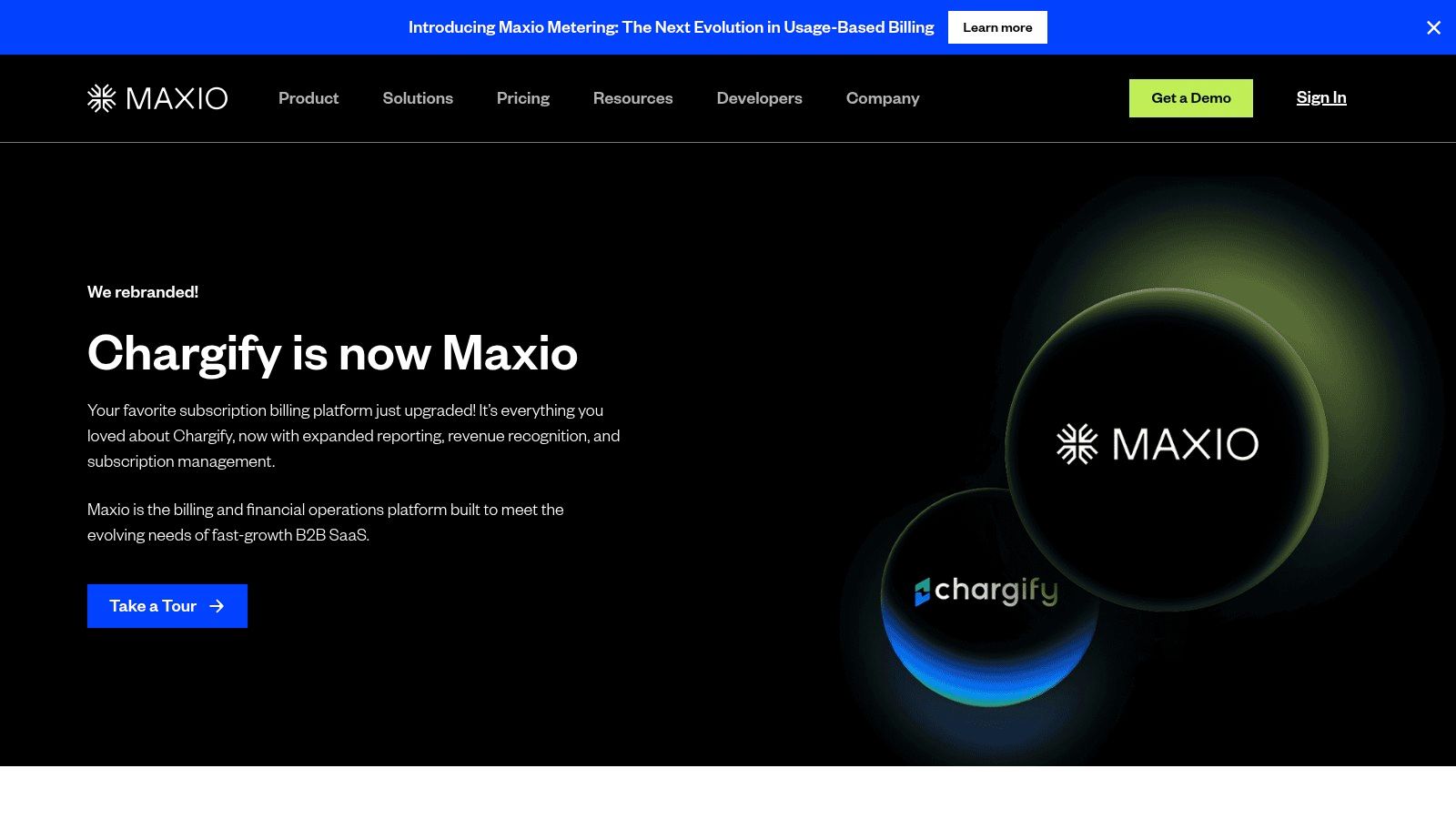
Chargify earns its place on this list due to its focus on sophisticated billing scenarios and data-driven optimization. Features like elastic billing for usage-based and hybrid pricing models set it apart from more basic subscription management tools. Furthermore, the built-in business intelligence and revenue analytics dashboards provide valuable insights into subscription performance, churn rates, and other key metrics. Automated subscription lifecycle management simplifies administrative tasks, while the customer self-service portal and branded invoices enhance the customer experience. Finally, robust revenue recognition and financial reporting tools ensure compliance and accurate financial tracking.
While Chargify excels in complex scenarios, its pricing might be a barrier for smaller businesses or startups with limited budgets. Some users also find the user interface less intuitive than some competitors. Additionally, while Chargify offers a robust API, its pre-built integrations with other platforms are somewhat limited compared to larger players in the market.
Key Features:
- Elastic Billing: Handles usage-based, tiered, and hybrid pricing models with ease.
- Business Intelligence: Provides comprehensive dashboards for revenue analytics and performance tracking.
- Automated Subscription Management: Automates recurring billing, renewals, and other lifecycle events.
- Customer Self-Service Portal: Empowers customers to manage their subscriptions and update payment information.
- Branded Invoices: Reinforces your brand identity and provides a professional billing experience.
- Revenue Recognition Tools: Simplifies compliance with accounting standards.
- API Flexibility: Allows for seamless integration with existing business systems.
Pros:
- Excellent for complex B2B pricing: Caters to sophisticated subscription models and pricing structures.
- Strong focus on business intelligence: Provides deep insights into revenue and subscription performance.
- Responsive customer support: Offers implementation assistance and ongoing support.
- Powerful developer tools: Enables customization and integration through a robust API.
Cons:
- Higher price point: Can be expensive for smaller businesses or startups.
- UI could be more intuitive: Some users find the interface less user-friendly than other options.
- Limited marketplace integrations: Fewer pre-built integrations compared to some larger platforms.
Website: https://www.chargify.com/
Implementation Tips:
- Take advantage of Chargify's implementation support to ensure a smooth setup.
- Clearly define your pricing models and subscription logic before implementation.
- Utilize the API to integrate Chargify with your existing CRM, accounting software, and other business systems.
- Explore the business intelligence dashboards to gain insights into your subscription performance and identify areas for optimization.
Chargify is a powerful tool for B2B SaaS businesses that require flexible and sophisticated subscription management. While the higher price point may deter smaller businesses, the robust features and focus on revenue optimization make it a compelling option for those with complex billing needs. If you’re prioritizing detailed analytics and the ability to handle intricate pricing structures, Chargify is well worth considering.
7. FastSpring
FastSpring stands out as a robust all-in-one ecommerce platform tailored for businesses selling software, SaaS, and digital products. It simplifies the complexities of subscription management by integrating global payments, tax compliance, and fraud prevention into a single solution. This makes it a powerful option for companies seeking streamlined operations, particularly those selling internationally. Unlike some subscription management software focused solely on recurring billing, FastSpring takes on the role of Merchant of Record (MoR), handling intricate tax calculations and compliance issues, freeing you to focus on product development and growth. This is a significant advantage for businesses looking to expand globally without the administrative headaches of navigating international tax laws. For tech-savvy individuals, families, small businesses, students, and digital nomads alike, this feature translates to a simplified experience, allowing them to access and manage their software subscriptions without worrying about compliance issues.

FastSpring's subscription management capabilities offer flexible billing options, allowing you to implement various pricing models, including tiered subscriptions, usage-based billing, and free trials. This flexibility is crucial for SaaS businesses and digital content creators who need to cater to different customer segments and offer a variety of pricing plans. Its built-in affiliate management system is another valuable asset, enabling businesses to leverage partnerships and expand their reach. The platform also supports multiple currencies and languages, further simplifying international sales and catering to a diverse customer base. This is particularly beneficial for digital nomads and businesses operating across borders.
Key Features:
- Merchant of Record Service: Handles tax and compliance globally.
- Global Payment Processing: Accepts 25+ payment methods.
- Subscription Management: Flexible billing options for various pricing models.
- Built-in Affiliate Management System: Expand your reach through partnerships.
- Localization: Multi-currency and multi-language support for global reach.
Pros:
- Global Tax Compliance & MoR: Simplifies international selling and minimizes administrative burden.
- All-in-One Solution: Reduces the need for multiple integrations.
- Strong Fraud Prevention: Protects your business from fraudulent transactions.
- Excellent for International Sales: Multi-currency support and localized payment options.
Cons:
- Higher Transaction Fees: Compared to payment-only processors.
- Less Customization Flexibility: May not suit businesses requiring highly customized payment flows.
- Limited Control over Payment Experience: FastSpring manages the payment process, limiting direct control.
- Less Suitable for Enterprise-Level Businesses: May not offer the scalability and advanced features required by large enterprises.
While FastSpring doesn't publicly list its pricing, it operates on a revenue-share model, meaning their fees are based on a percentage of your sales. This makes it essential to carefully consider your sales volume and average transaction value when evaluating its cost-effectiveness. Contact FastSpring directly for detailed pricing information tailored to your specific business needs. Technical requirements are minimal as FastSpring is a cloud-based platform accessible through a web browser. Implementation involves setting up your product catalog, configuring your subscription plans, and integrating with your existing systems. While FastSpring offers robust documentation and support, businesses with complex requirements may require some technical expertise during the initial setup.
Compared to payment-only processors like Stripe or Braintree, FastSpring offers a more comprehensive solution by handling tax and compliance, making it a more attractive option for businesses selling internationally. However, if you require extensive customization of the payment experience or have highly complex enterprise-level needs, you may need to consider more specialized subscription management software. For the target audience of tech-savvy individuals, families, and small businesses, FastSpring strikes a balance between ease of use and comprehensive features. It simplifies global access to software and digital services, providing a secure and efficient platform for managing subscriptions.
Website: https://fastspring.com/
8. Paddle
Paddle stands out as a comprehensive solution specifically designed for SaaS businesses, offering more than just subscription management. It combines subscription billing, payment processing, and global tax compliance into a single platform. This makes it particularly attractive for companies selling software internationally, removing the complexities of navigating different tax laws and regulations. Instead of piecing together disparate tools for each of these functions, Paddle streamlines operations under one roof. This positions Paddle as a robust option for businesses focused on scaling their software offerings globally.

One of Paddle's key differentiators is its role as a Merchant of Record (MoR). This means Paddle handles the responsibility of collecting and remitting sales tax/VAT globally. For businesses selling internationally, this simplifies a significant administrative burden, freeing up resources to focus on product development and growth. This feature makes Paddle a strong contender for businesses facing the challenges of global expansion. Imagine launching your software in multiple countries without the headache of managing diverse tax regulations - that's the value proposition Paddle brings to the table.
Paddle offers flexible subscription billing models, trial management, checkout optimization tools (including A/B testing), and a revenue recovery system to address failed payments. The platform also provides a clean, modern interface and intuitive dashboard with revenue and subscription analytics, simplifying reporting and providing valuable insights into business performance. These features are essential for subscription management software, empowering businesses to optimize their revenue streams.
Features:
- Merchant of record service handling global tax compliance
- Subscription billing with flexible models and trial management
- Checkout optimization and A/B testing tools
- Revenue recovery system with smart failed payment handling
- Intuitive dashboard with revenue and subscription analytics
Pros:
- Simplifies global tax compliance as merchant of record
- Clean, modern interface with easy implementation
- Handles multiple currencies and payment methods effortlessly
- Built-in checkout optimization for higher conversion rates
Cons:
- Higher fees compared to traditional payment processors. While Paddle simplifies global commerce, this convenience comes at a cost. Businesses should carefully evaluate the fee structure against their projected revenue to ensure profitability.
- Less flexible for highly customized subscription models. While offering flexibility, Paddle may not cater to businesses with exceptionally niche subscription requirements.
- Limited integration options compared to some competitors. This might be a consideration for businesses reliant on a specific third-party tool.
- Primarily designed for digital products/software. This specialization limits its applicability to other industries.
Pricing: Paddle operates on a percentage-of-revenue pricing model, which scales with your sales. Contact Paddle directly for specific pricing information.
Technical Requirements: Implementation involves integrating Paddle's checkout system into your website or app. Paddle provides documentation and support to facilitate this process.
Comparison: Compared to traditional payment processors like Stripe or Braintree, Paddle offers a more comprehensive solution specifically geared towards SaaS businesses by handling the complexities of global tax compliance. However, this specialized service often comes at a higher price point.
Implementation Tips:
- Thoroughly review Paddle's documentation and utilize their support resources for integration assistance.
- Take advantage of the A/B testing tools to optimize your checkout process for conversions.
- Leverage the analytics dashboard to gain insights into subscriber behavior and revenue trends.
Website: https://www.paddle.com/
Paddle's value lies in its streamlined approach to global SaaS sales and its comprehensive handling of tax complexities. While the higher fees might be a concern for some, the time and resources saved on tax management can often offset the cost, especially for businesses rapidly scaling internationally. This makes it a valuable tool for tech-savvy individuals, small businesses, and digital nomads selling software globally.
9. Recharge
Recharge is a leading subscription management software specifically designed for ecommerce businesses selling physical products and consumables. It’s a particularly popular choice for those operating on platforms like Shopify and BigCommerce, earning its reputation as the top subscription solution in the Shopify ecosystem. If your business model revolves around subscription boxes, replenishment services, or membership programs focused on tangible goods, Recharge is worth serious consideration. It enables recurring billing and provides customers with the tools they need to easily manage their subscriptions, making it a powerful tool for boosting customer retention and streamlining operations.

Recharge's robust feature set empowers businesses to optimize their subscription services. A key feature is the customer portal, which allows subscribers to manage their subscriptions, update delivery schedules, skip shipments, swap products, and more, all without needing to contact customer support. This self-service functionality greatly enhances the customer experience. For businesses, Recharge offers inventory planning and fulfillment management tools to ensure smooth operations, along with detailed analytics on subscription metrics and churn rates, enabling data-driven decisions for growth and improved customer retention. Automated transactional emails and notifications keep customers informed and engaged throughout their subscription lifecycle.
For example, a small business selling organic coffee beans through a subscription box model could leverage Recharge to automate recurring billing, manage inventory based on subscription numbers, and allow customers to customize their delivery frequency and bean selections through the customer portal. This streamlines the entire subscription process, from order placement to delivery, freeing up the business to focus on other critical areas.
Pros:
- Purpose-built for physical product subscriptions: Recharge excels in managing the complexities of recurring billing for physical goods.
- Seamless integration with major ecommerce platforms: Its integration with Shopify and BigCommerce is particularly noteworthy, making it an easy choice for businesses already using these platforms.
- Intuitive customer management portal: Empowers customers with self-service options, enhancing their overall experience.
- Strong focus on reducing churn for physical products: Features like flexible subscription management and proactive communication tools contribute to improved customer retention.
Cons:
- Less suitable for digital subscriptions or complex SaaS billing: Recharge's focus on physical products makes it less ideal for businesses offering digital services or software.
- Limited customization options for some elements: While generally robust, some aspects of the platform offer limited flexibility in terms of customization.
- Higher transaction fees on lower-tier plans: Businesses on tighter budgets should carefully consider the transaction fees associated with the lower-tier plans.
- Some advanced features require higher plans: Accessing the full suite of features may require opting for a more expensive plan.
Pricing and Technical Requirements:
Pricing information is available on the Recharge website and is generally tiered based on transaction volume and features. Technical requirements are minimal as Recharge integrates directly with existing ecommerce platforms.
Comparison with Similar Tools:
While other subscription management software options exist, Recharge stands out due to its specialization in physical products and tight integration with leading ecommerce platforms. Alternatives like Bold Subscriptions and Subbly might be more suitable for businesses with different needs, such as digital product subscriptions or more complex billing structures.
Implementation and Setup Tips:
Implementing Recharge is typically straightforward, especially for businesses already using Shopify or BigCommerce. Leverage the available documentation and support resources for a smooth setup process. Start with a smaller product offering or a pilot program to familiarize yourself with the platform before scaling up your subscription services.
Recharge deserves its place on this list because it effectively addresses the specific needs of ecommerce businesses selling physical products through subscriptions. Its focus on customer experience, combined with robust management tools, makes it a valuable asset for businesses looking to grow and optimize their subscription revenue. You can explore Recharge and its features further on their website: https://rechargepayments.com/
10. 2Checkout (now Verifone)
2Checkout, now operating under Verifone, offers a comprehensive platform that goes beyond simple payment processing, integrating robust subscription management capabilities with global tax compliance and a wide range of payment options. This makes it a particularly attractive option for businesses selling digital products internationally. By consolidating payment processing, recurring billing, and tax management into a single platform, 2Checkout streamlines operations, especially for businesses navigating the complexities of global commerce. This solution is ideal for those who prioritize international reach and simplified tax handling.
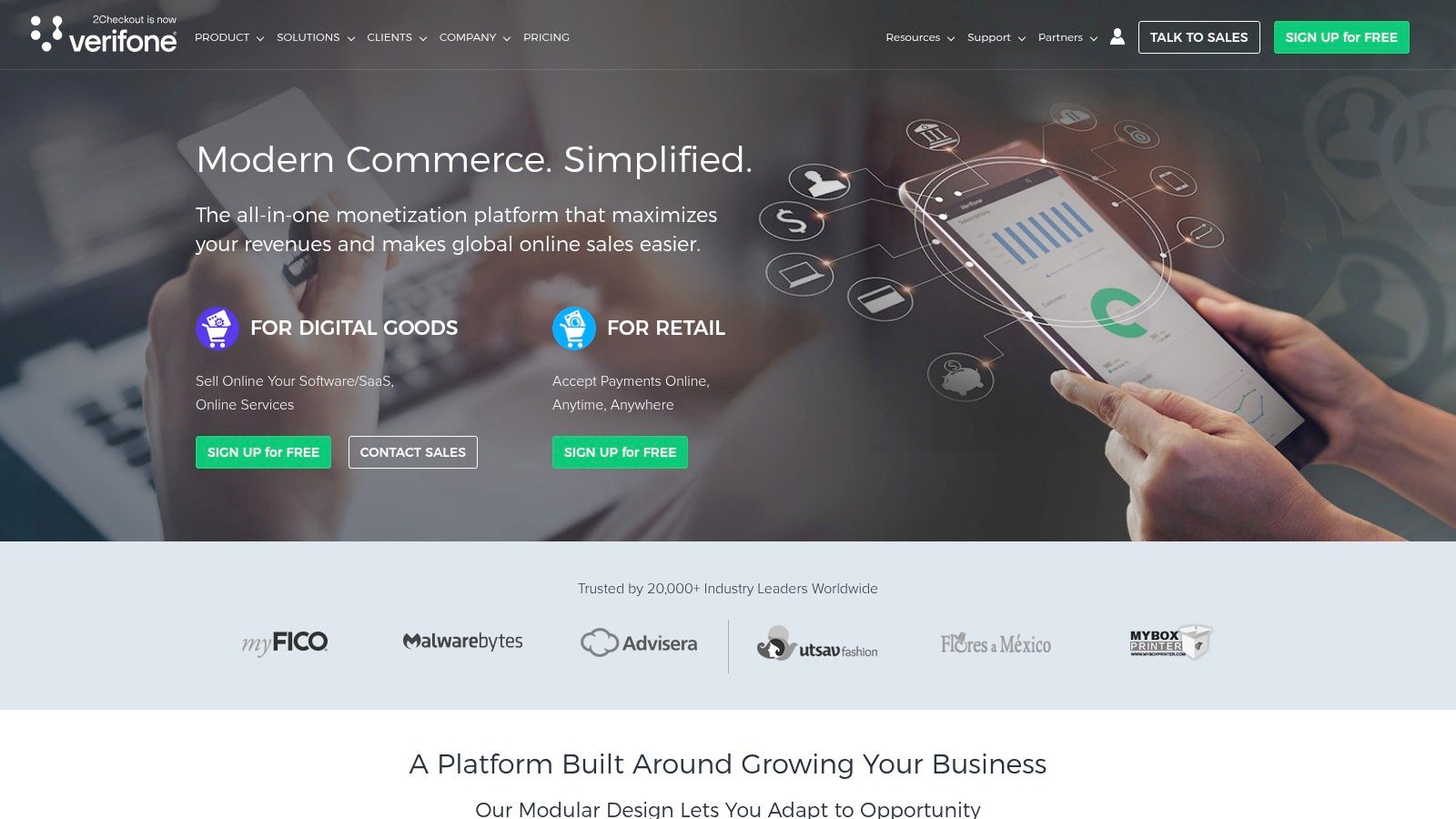
For businesses seeking subscription management software that can handle the intricacies of global sales, 2Checkout stands out. Its strength lies in its ability to process payments in over 100 currencies, supporting 45+ payment methods. This extensive coverage caters to diverse customer preferences, maximizing conversion rates in international markets. The platform's automated recurring billing feature simplifies subscription management, ensuring timely payments and reducing administrative overhead. Furthermore, 2Checkout's role as a merchant of record alleviates the burden of global tax compliance, handling complex tax regulations in over 200 countries. This feature is invaluable for businesses expanding their global footprint, saving them time and resources.
The customizable checkout experience, including localization options, further enhances conversion rates by providing a tailored experience for international customers. Integrated affiliate marketing tools also contribute to business growth by facilitating partnerships and expanding reach. While pricing details are not readily available and typically tailored to individual business needs, the robust features and global capabilities make 2Checkout a strong contender for businesses with international aspirations. Tech-savvy individuals seeking premium services from global providers will find the wide array of payment methods beneficial. Small businesses aiming to expand globally will appreciate the simplified tax compliance and localized checkout options.
Features:
- Global payments with 45+ payment methods and 100+ currencies
- Subscription management with recurring billing automation
- Merchant of record service handling global tax compliance
- Customizable checkout with localization options
- Integrated affiliate marketing platform
Pros:
- Excellent global coverage with localized payment methods
- Handles international tax compliance as merchant of record
- Strong fraud prevention capabilities (not explicitly listed but worth mentioning given the payment processing nature)
- Supports both one-time and subscription billing models
Cons:
- Higher fees compared to payment-only processors (this is a common trade-off for all-in-one solutions)
- User interface can feel dated compared to newer solutions (consider this if a modern UI/UX is a priority)
- Customer support can be inconsistent according to some users (research and consider alternative options if reliable support is crucial)
- Less specialized for complex subscription scenarios (suitable for standard subscriptions but may lack features for highly customized subscription models)
Website: https://www.2checkout.com/
Implementation Tips:
- Carefully evaluate the fee structure to ensure it aligns with your business model and projected revenue.
- Test the checkout process thoroughly in different countries to ensure a seamless customer experience.
- Leverage the localization options to maximize conversion rates in target markets.
2Checkout earns its place on this list due to its unparalleled global reach and comprehensive approach to subscription management, effectively merging payment processing, recurring billing, and tax compliance into a unified platform. While the interface might appear less modern and fees may be higher than payment-only solutions, its value proposition lies in simplifying international sales and tax complexities, making it an attractive option for businesses focused on global expansion.
Top 10 Subscription Management Tools: Quick Comparison
| Platform | Core Features (✨) | User Experience (★) | Value (💰) | Target Audience (👥) |
|---|---|---|---|---|
| 🏆AccountShare | Group buying & secure shared account management | Fast response & high availability | Premium subscriptions from $10 | Tech-savvy users, families, SMEs, digital nomads |
| Chargebee | Automated billing, trial management, analytics | Highly flexible with extensive integrations | Premium pricing for full feature set | Startups to enterprises |
| Recurly | Advanced dunning, revenue recovery, global billing | Reliable churn reduction & robust API | Higher cost for advanced recovery tools | SaaS, digital media, e-commerce |
| Stripe Billing | Usage-based billing with smart dunning & APIs | Developer-friendly, seamless Stripe integration | Transparent pricing with competitive fees | Businesses in Stripe ecosystem |
| Zuora | End-to-revenue automation, revenue recognition | Enterprise-grade, complex but powerful | High cost for complex models & scaling | Large enterprises |
| Chargify | Elastic billing models, revenue analytics | Intuitive for complex B2B pricing scenarios | Higher price point for specialized features | B2B SaaS companies |
| FastSpring | Merchant of record, global payments & compliance | Integrated, all-in-one ecommerce experience | Higher transaction fees for full service | Digital product & SaaS companies |
| Paddle | Global tax compliance, checkout optimization | Clean, modern interface with easy setup | Fees reflect added compliance & conversion tools | SaaS and international digital sellers |
| Recharge | Subscription management for physical products | Intuitive customer portal & delivery scheduling | Transaction fees with essential tools | Ecommerce & subscription box businesses |
| 2Checkout (Verifone) | Global payments, localized methods & tax management | Robust fraud prevention, though dated UI | Higher fees for broad international support | Global digital product sellers |
Choosing the Right Subscription Management Software
Finding the perfect subscription management software can feel overwhelming with so many options available. This article explored ten popular platforms, from established players like Zuora and Chargebee to emerging solutions like AccountShare and Recharge. Each offers a unique blend of features, catering to various business sizes and needs. Remember, the ideal choice depends on factors like your budget, required integrations (e.g., payment gateways, CRM), scalability for future growth, and the complexity of your subscription models. Carefully evaluating these aspects will ensure you select a platform that streamlines your operations and maximizes your revenue potential.
Beyond choosing the right software, optimizing your customer support workflows is crucial for efficient subscription management. Automating key processes can significantly improve customer satisfaction and reduce churn. Learn more about how to automate customer support from TriageFlow's comprehensive playbook on building service excellence. Implementing these strategies alongside your chosen software can help you create a seamless and positive subscriber experience.
Successfully managing subscriptions goes beyond just billing; it's about building lasting customer relationships. By focusing on both efficient management and exceptional customer service, you can drive growth and ensure the long-term success of your subscription business. Looking for a smart way to manage and share your personal subscriptions? Explore AccountShare, a platform designed to help you easily and securely share subscription access with family and friends, optimizing your spending and simplifying digital life.
